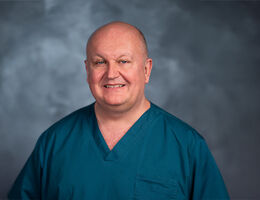

Fourth-year medical student Jairo Campos, left, recently shadowed community health worker Richard Salazar as he worked with patients in the community.
Fourth-year medical student Jairo Campos recently spent a day in San Bernardino with a Loma Linda University Health community health worker, visiting homes of patients, motels where some patients go after hospital discharges, and meeting gunshot victims.
Campos said the ride-along opened his eyes to how community health workers contribute to the healthcare system by helping patients in the hospital, in homes, or on the street with their care. Many patients the community health worker see suffer from drug addiction, homelessness, or gang violence — social drivers of health that go beyond what doctors can do for them while they’re hospitalized.
“It was really eye-opening to see the potential that the community health workers have because of the connection they have with the community,” Campos said. “They’re there. They’ve lived there. They’re part of that community.”
Campos’ participation was required of him for Loma Linda University School of Medicine’s whole-person care clerkship, a new, two-week program led by Paige Stevens, MD, of hands-on training for fourth-year medical students that includes a requirement to shadow a community health worker. Students visit homes to see first-hand caregiving situations and experience environments that determine drivers of health. This enables them to better understand how community health workers work upstream to address the root causes of a patient’s health condition.
School leaders say students consistently give the program high ratings and is an inspiring part of healthcare as the industry grows increasingly complex and sometimes overwhelming.
“We hope as this generation of doctors graduates they will really understand how they can utilize community partners, because right now care of some patients can feel overwhelming,” says Amy Hayton, MD, MPH, associate dean of physician formation and wholeness. “This is especially key for a patient’s social drivers of health and some of the issues that patients have that we as physicians can’t immediately solve.”
In recent years, the school’s curriculum has further integrated Loma Linda University Health’s approach to whole person care. They have been teaching students about community health workers and offered intermittent shadowing opportunities that were consistently highly rated.
Community health workers are trusted members of the community who build bridges between clinical care and local citizens. Their shared experience allows them to have a fundamental understanding of the culture, languages, challenges, and health-related needs patients may face. Community health workers help patients navigate the healthcare system, reduce patients’ preventable hospitalizations and readmissions, increase positive long-term population health outcomes and lower health care costs.
LLUH is a regional leader in community health worker integration into healthcare and has recognized the need for them as an integral part of complex healthcare teams. LLUH only offers full-time benefited positions. Community health workers complement conventional medical care by helping to address patient’s basic health needs.
Hayton says School of Medicine leaders got the idea to integrate the community health worker shadowing initiative into the required fourth-year clerkship after presenting at a conference on religion and medicine. Their presentation on community health workers challenged and encouraged the audience.
“Personally, I think we need to continue to spread the word that community health workers are one of the most hopeful assets in healthcare,” Hayton says.
The whole person care clerkship also includes shadowing a chaplain and multiple clinical faculty, simulation experiences with a pediatric death, spiritual care for a non-religious patient, practicing how to deliver challenging news to patients, as well as the community health worker shadowing requirement. All 180 fourth-year medical students complete the clerkship.
Loma Linda University Health now employs 14 community health workers, up from three when it began hiring for the position in 2018. They work across various departments, including violence prevention and trauma, maternity services, neonatal intensive care, patients at risk for or living with HIV, patients with diabetes, and frequent utilizers of the Emergency Department, among others.
Campos says his shadow day included a hospital visit to a gun-shot victim’s bedside. A nurse had just walked out of the patient’s room along with a team of doctors. Campos recognized that the community health worker had a unique bridge between the care team and the patient. He says when the patient saw the community health worker, his whole demeanor changed.
“The patient’s face changed, his mood, his expression, everything about him told you he was way more open to Richard, the community health worker, than he was to the medical care team.”
Richard Salazar, who has worked at LLUH as a community health worker since 2024, says he has one fourth-year medical student shadow him each week. He says he enjoys teaching them about resources available in the community and in the hospital, showing how patients need to be supported, and how to deal with patients who don’t cooperate well but are in need, such as those in drug withdrawal.
Salazar says downtown San Bernardino and Loma Linda University may only be seven miles apart, but the environments are very different. It’s important for future doctors to know the real environment in which many of their patients live. He says many medical students who shadow him request to stay for another hour or two after their time is up.
“I think this shadowing is a great idea,” Salazar says. As people start doing this as part of their program, they’re going to become more comfortable. As people become more comfortable, it will be more routine, and then it will become part of our tradition.”
—Donna Jayne Potts contributed to this story


